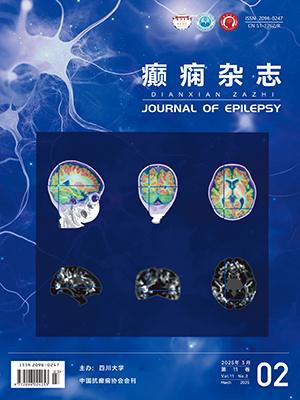| 1. |
Mouthaan BE, Rados M, Barsi P, et al. Current use of imaging andelectromagnetic source localization procedures in epilepsy surgerycenters across Europe. Epilepsia, 2016, 57(5): 770-776.
|
| 2. |
Kobulashvili T, Hofler J, Dobesberger J, et al. Current practices inlong-term video-EEG monitoring services: asurvey among partners ofthe E-PILEPSY pilot network of reference for refractory epilepsy andepilepsy surgery. Seizure, 2016, 38: 38-45.
|
| 3. |
Helmstaedter C, Witt JA. Clinical neuropsychology in epilepsy: theoreticaland practical issues. Handb Clin Neurol, 2012, 107: 437-459.
|
| 4. |
Aikia M, Salmenpera T, Partanen K, et al. Verbal memory in newlydiagnosed patients and patients with chronic left temporal lobe epilepsy. Epilepsy Behav, 2001, 2(1): 20-27.
|
| 5. |
Sherman EM, Wiebe S, Fay-McClymont TB, et al. Neuropsychologicaloutcomes after epilepsy surgery: systematic review and pooled estimates. Epilepsia, 2011, 52(5): 857-869.
|
| 6. |
Helmstaedter C. Cognitive outcomes of different surgical approachesin temporal lobe epilepsy. Epileptic Disord, 2013, 15(3): 221-239.
|
| 7. |
Bjellvi J, Flink R, Rydenhag B, et al. Complications of epilepsy surgeryin Sweden 1996-2010: a prospective, population-based study. J Neurosurg, 2015, 122(3): 519-525.
|
| 8. |
Van Schooneveld MM, Braun KP. Cognitive outcome after epilepsysurgery in children. Brain Dev, 2013, 35(8): 721-729.
|
| 9. |
Langfitt JT, Westerveld M, Hamberger MJ, et al. Worsening of qualityof life after epilepsy surgery: effect of seizures and memory decline. Neurology, 2007, 68(23): 1988-1994.
|
| 10. |
Helmstaedter C. Temporal lobe resection-does the prospect of seizurefreedom outweigh the cognitive risks? Nat Clin Pract Neurol, 2008, 4(2): 66-67.
|
| 11. |
Boshuisen K, van Schooneveld MM, Uiterwaal CS, et al. IQ improvesafter antiepileptic drug withdrawal following pediatric epilepsy surgery. Ann Neurol, 2015, 78(1): 104-114.
|
| 12. |
Chelune GJ, Naugle RI, Luders H, et al. Prediction of cognitive changeas a function of preoperative ability status among temporal lobectomypatients seen at 6-month follow-up. Neurology, 1991, 41: 399-404.
|
| 13. |
Wilson SJ, Saling MM, Lawrence J, et al. Outcome of temporal lobectomy: expectations and the prediction of perceived success. EpilepsyRes, 1999, 36(1): 1-14.
|
| 14. |
Helmstaedter CA. Prediction of memory reserve capacity. Adv Neurol, 1999, 81: 271-279.
|
| 15. |
Gross RE, Mahmoudi B, Riley JP. Less is more: novel less-invasivesurgical techniques for mesial temporal lobe epilepsy that minimizecognitive impairment. Curr Opin Neurol, 2015, 28(2): 182-191.
|
| 16. |
Keezer MR, Sisodiya SM, Sander JW. Comorbidities of epilepsy: currentconcepts and future perspectives. Lancet Neurol, 2016, 15(1): 106-115.
|
| 17. |
Helmstaedter C, Aldenkamp AP, Baker GA, et al. Disentangling therelationship between epilepsy and its behavioral comorbidities-theneed for prospective studies in new-onset epilepsies. Epilepsy Behav, 2014, 31: 43-47.
|
| 18. |
Gilliam F, Kanner AM. Treatment of depressive disorders in epilepsypatients. Epilepsy Behav, 2002, 3(5S): 2-9.
|
| 19. |
Cramer JA. Principles of health-related quality of life: assessment inclinical trials. Epilepsia, 2002, 43(9): 1084-1095.
|
| 20. |
Wilson SJ, Baxendale S, Barr W, et al. Indications and expectationsfor neuropsychological assessment in routine epilepsy care: report ofthe ILAE Neuropsychology Task Force, Diagnostic Methods Commission, 2013-2017. Epilepsia, 2015, 56(5): 674-681.
|
| 21. |
Jones-Gotman M, Smith ML, Zatorre RJ. Neuropsychological testingfor localizing and lateralizing the epileptogenic region. In Engel J (Ed)Surgical treatment of the epilepsies. New York, NY: Raven Press, 1993: 245-262.
|
| 22. |
Rabin LA, Barr WB, Burton LA. Assessment practices of clinical neuropsychologistsin the United States and Canada: a survey of INS, NAN, and APA Division 40 members. Arch Clin Neuropsychol, 2005, 20(1): 33-65.
|
| 23. |
Djordjevic J, Jones-GotmanM. Inquiry on assessments across epilepsycenters in different countries. In Helmstaedter C, Hermann B, LassondeM, Kahane P, Arzimanoglou A. (Eds) Neuropsychology in thecare of people with epilepsy. Paris: John Libbey Eurotext, 2011: 13-26.
|
| 24. |
Witt JA, Helmstaedter C. A survey on neuropsychological practice inGerman-speaking epilepsy centers. 27-32. In Helmstaedter C, HermannB, Lassonde M, Kahane P, Arzimanoglou A (EDs). Neuropsychologyin the care of people with epilepsy. John Libbey Eurotext, 2011.
|
| 25. |
Helmstaedter C, Witt JA. Clinical neuropsychology in epilepsy: theoreticaland practical issues. Handb Clin Neurol, 2012, 107: 437-459.
|
| 26. |
Witt JA, Helmstaedter C. Neuropsychology in epilepsy part II: towardsan establishment of diagnostic guidelines. Fortschr Neurol Psychiatr, 2009, 77: 691-698.
|
| 27. |
Brückner K. Standard of neuropsychological testing in presurgicalepilepsy diagnostics. Statement of the neuropsychologicalcommission of the DGfE. Z Epileptol, 2012, 25: 1-5.
|
| 28. |
Witt JA, Bodner T, Bruckner K, et al. Is there a common basis forestablishing guidelines for the neuropsychological assessment inepilepsy?. A Survey across German Epilepsy Centres. Epilepsia, 2009, 50: 45.
|
| 29. |
Lezak MD, Howieson DB, Bigler ED, et al. Neuropsychologicalassessement. Oxford: Oxford University Press, 2012.
|
| 30. |
Strauss E, Shermann EMS, Spreen O. A compendium of neuropsychologicaltests: administration, norms, and commentary. Oxford: Oxford University Press, 2006.
|
| 31. |
Baxendale S. The Wada test. Curr Opin Neurol, 2009, 22(2): 185-189.
|
| 32. |
Helmstaedter C, Witt JA. Neuropsychology in epilepsy part I: cognitiveimpairments in focal epilepsies. Fortschr Neurol Psychiatr, 2009, 77(11): 639-645.
|
| 33. |
Scoville WB, Milner B. Loss of recent memory after bilateralhippocampal lesions. 1957. J Neuropsychiatry Clin Neurosci, 2000, 12(1): 103-113.
|
| 34. |
Haag A, Knake S, Hamer HM, et al. The Wada test in Austrian, Dutch, German, and Swiss epilepsy centers from 2000 to 2005: a review of 1421 procedures. Epilepsy Behav, 2008, 13(1): 83-89.
|





 Baidu Scholar
Baidu Scholar